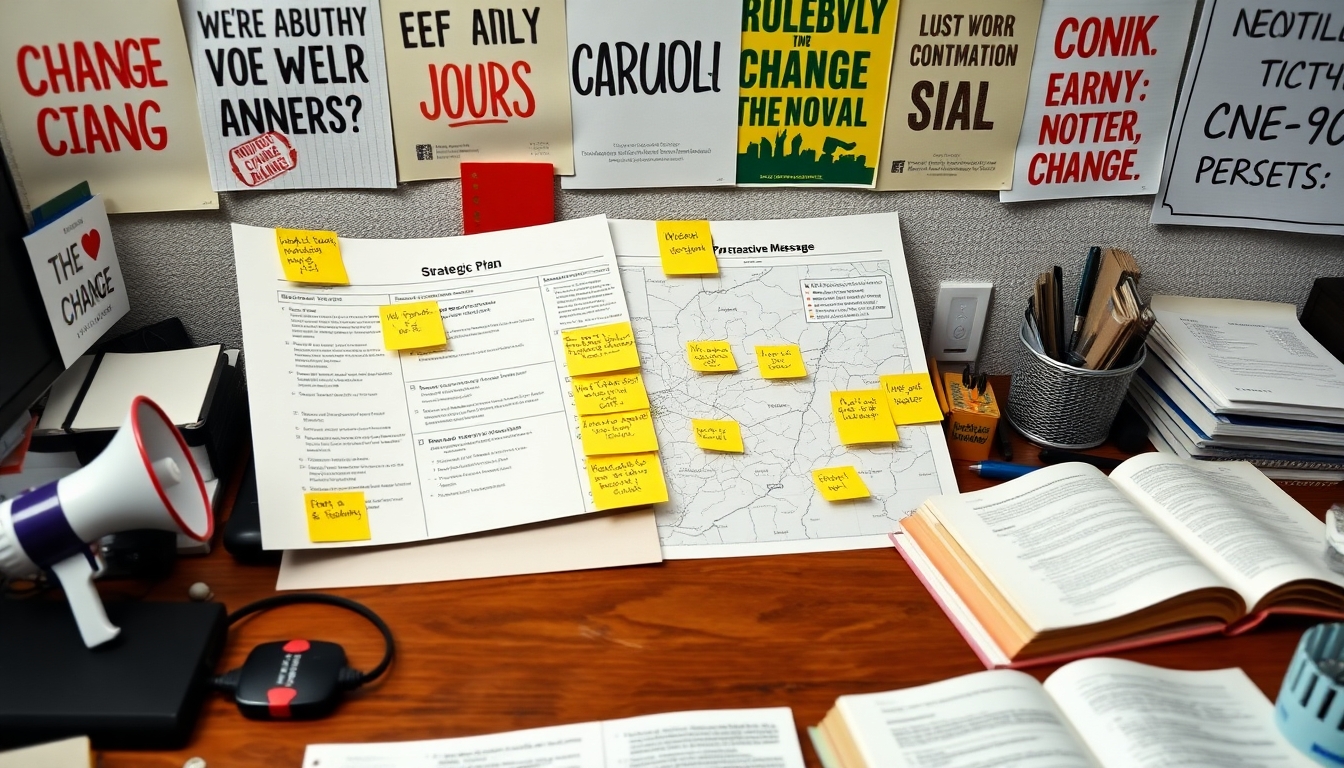Ever felt like you’re shouting into the void, hoping for change? You’re not alone. Advocacy is like a journey, and just like any journey, it needs a map. This guide is your map, helping you navigate the twists and turns of advocating for change. Whether you’re fighting for environmental policies or pushing for educational reforms, the steps are the same. Clear goals, understanding your audience, crafting messages, selecting tactics, and overcoming challenges. Let’s dive in!
First things first, know what you want. Imagine trying to hit a target blindfolded. That’s what it’s like advocating without clear goals. Your goals should be as clear as a sunny day. Make them specific, measurable, achievable, relevant, and time-bound (SMART). These goals are your guiding stars, lighting the way and helping you measure success. Without them, you’re just wandering in the dark.
Now, who needs to hear what you have to say? Identifying your audience is like finding the right key for a lock. You need to know who the decision-makers are, who can help, and who might be standing in your way. Tailor your message to these folks. Speak their language, understand their needs. This way, your message hits home, making them sit up and take notice.
Imagine your message as a story. A story that grabs attention, tugs at heartstrings, and sticks in the mind. Your advocacy message should be clear and emotional, backed by solid evidence. It’s the secret sauce that inspires action. Think of it as a bridge, connecting your cause to the hearts and minds of your audience. Make it count.
With your message ready, it’s time to choose your weapons. Whether it’s grassroots mobilization, digital campaigns, or something else, your tactics should align with your goals and resources. Think of tactics as tools in a toolbox. Each has its purpose, and using the right one can make all the difference. Choose wisely, and watch your efforts bear fruit.
Advocacy isn’t always a walk in the park. You’ll face resistance, resource limitations, and communication barriers. But don’t let that stop you. Think of challenges as hurdles in a race. With strategic planning and adaptability, you can leap over them. Stay persistent, keep your eyes on the prize, and remember why you started. Your cause is worth it.
Identifying Your Advocacy Goals and Objectives
So, you’ve decided to become an advocate. That’s fantastic! But where do you start? The first step is to clearly define your goals and objectives. Think of these as your roadmap. Without them, you might find yourself wandering aimlessly, unsure of where you’re headed. It’s like trying to bake a cake without a recipe. You might end up with something sweet, but it probably won’t be what you intended.
To make your advocacy efforts effective, your goals should be SMART: Specific, Measurable, Achievable, Relevant, and Time-bound. Let’s break that down. Being specific means knowing exactly what you want to achieve. Instead of saying, “I want to improve education,” you might say, “I want to increase funding for arts programs in local schools by 10% within the next year.”
Next, ensure your goals are measurable. If you can’t measure it, how will you know if you’ve succeeded? Then comes achievable. While it’s great to aim high, setting unrealistic goals can lead to disappointment. Make sure your objectives are within reach, given your resources and constraints.
Now, let’s talk about relevance. Your goals should align with your values and the broader mission of your advocacy. If you’re passionate about environmental issues, your objectives should reflect that passion. Finally, every goal needs a time frame. Setting a deadline creates urgency and helps keep you on track.
In the end, identifying your advocacy goals is all about clarity and focus. It’s about knowing not just where you want to go, but how you plan to get there. So grab a pen, jot down your thoughts, and start mapping out your advocacy journey. Remember, every great movement started with a simple, well-defined goal. What’s yours?
Target Audience Analysis: Who Needs to Hear Your Message?
Imagine standing in a crowded room, shouting your message at the top of your lungs. Yet, no one seems to hear you. Frustrating, right? That’s what happens when you don’t know who your audience is. Understanding your audience is like having a map in a treasure hunt. It guides you, ensuring that your efforts aren’t wasted. But how do you pinpoint who needs to hear your message?
First, think about the people who can make a difference. These are your key stakeholders. They might be decision-makers, influencers, or even the everyday person whose opinion matters. It’s like choosing the right players for a basketball team. You need the right mix of skills and strengths to win the game.
Next, consider potential allies. These are individuals or groups who share your vision. They might not be directly involved, but they can amplify your voice. Picture them as the cheerleaders on the sideline, boosting your morale and spreading your message further.
Lastly, don’t forget about those who might resist your message. Understanding their perspective can help you tailor your approach. It’s like knowing your opponent’s strategy in a chess game. By anticipating their moves, you can plan your next steps more effectively.
In summary, knowing your audience is crucial for advocacy. It’s about finding the right ears for your message. So, take the time to analyze and understand who needs to hear you. Because when you speak to the right people, your voice becomes a powerful tool for change.
Crafting a Compelling Advocacy Message
Creating a message that hits the bullseye is like crafting a masterpiece. It requires a blend of clarity, emotion, and solid evidence. Imagine you’re painting a picture. Every brushstroke matters. Similarly, every word in your message should count. Start by focusing on clarity. Make sure your message is straightforward. No one likes a riddle when they’re trying to understand an important issue. Use simple language. Keep it concise. Your audience should grasp your point without needing a dictionary.
Next, sprinkle in some emotion. People connect with feelings. Think about a time when a story moved you. It wasn’t just the facts, was it? It was the heart of the story. So, paint a picture with your words. Use analogies and metaphors to make your message relatable. Help your audience feel the urgency and importance of your cause. This emotional connection can be the spark that ignites action.
Finally, back up your message with evidence. Imagine trying to build a house without a foundation. It wouldn’t stand for long, right? Similarly, your message needs a strong foundation of facts. Use data, statistics, and real-life examples to support your claims. This not only strengthens your argument but also builds trust with your audience.
In summary, a compelling advocacy message is like a well-crafted story. It combines clarity, emotion, and evidence to inspire action. Remember, your message is the bridge between your cause and the change you want to see. So, make it strong, make it clear, and make it resonate.
Choosing the Right Advocacy Tactics
When it comes to advocacy, picking the right tactics is like choosing the right tool for the job. You wouldn’t use a hammer to fix a leaky faucet, right? Similarly, your advocacy tactics should align with your goals, audience, and the resources you have at hand. Consider this your toolbox for change.
First off, think about your audience. Are you trying to reach policymakers, the general public, or a specific community group? Each audience requires a different approach. For instance, if you’re aiming to influence policymakers, you might opt for direct lobbying or policy briefings. But if you’re targeting the public, grassroots mobilization or social media campaigns might be more effective.
Next, assess your resources. This includes time, money, and manpower. If you’re working with limited resources, digital campaigns can be a cost-effective way to spread your message far and wide. However, if you have more resources at your disposal, organizing events or rallies could provide a more personal touch.
Don’t forget the power of storytelling. A compelling narrative can be a game-changer in advocacy. Personal stories can create an emotional connection with your audience, making your cause more relatable and urgent. Think of it as the heart of your campaign, pumping life into your message.
Finally, be prepared to adapt. Advocacy is not a one-size-fits-all endeavor. You may need to tweak your tactics as you go along. Stay flexible and responsive to feedback, and don’t be afraid to try new approaches if your initial strategies aren’t working. Remember, persistence is key.
Overcoming Common Advocacy Challenges
Advocacy isn’t a walk in the park. It’s more like a hike up a steep mountain. You face resistance, run into resource limitations, and sometimes hit communication barriers that seem insurmountable. But don’t let these challenges throw you off course. With a bit of strategic planning, adaptability, and sheer perseverance, you can keep your advocacy train chugging along.
Resistance is often the first hurdle. People can be set in their ways, and change isn’t always welcome. It’s like trying to convince a cat to take a bath. Tough, right? The key is to understand where the resistance is coming from. Is it fear of the unknown? Or perhaps a lack of understanding? Once you pinpoint the cause, you can tailor your approach. Maybe a little education or a compelling story can turn the tide.
Resource limitations can also feel like a ball and chain. Money, time, and manpower are often in short supply. But here’s the silver lining: creativity doesn’t cost a dime. Think outside the box. Consider forming alliances with other groups. Pool resources. Share the load. It’s amazing what a bit of collaboration can achieve.
Communication barriers can be the trickiest to overcome. It’s like playing a game of telephone where the message gets muddled along the way. Clear, concise, and consistent messaging is your best friend here. Use multiple channels to reach your audience. And remember, it’s not just about talking. Listening is just as important.
So, while the path to effective advocacy is fraught with challenges, it’s these very obstacles that can make the journey rewarding. Embrace them. Learn from them. And let them fuel your passion for change.
Frequently Asked Questions
- What is the first step in advocating for change?
The journey of advocacy begins with setting clear and well-defined goals. Think of it as plotting a course on a map before setting sail. Your goals should be specific, measurable, achievable, relevant, and time-bound (SMART) to ensure you’re not wandering aimlessly.
- How do I identify my target audience for advocacy?
Understanding your audience is like knowing your dance partner’s moves. Identify key stakeholders, decision-makers, and potential allies. Tailoring your message to these groups can maximize your impact and ensure your message hits home.
- What makes an advocacy message compelling?
Crafting a compelling message is akin to writing a captivating story. It should be clear, emotionally engaging, and backed by evidence. This trifecta can inspire action and rally support for your cause.
- What are some effective advocacy tactics?
Choosing the right tactics is like picking the right tool for a job. Whether it’s grassroots mobilization or digital campaigns, your tactics should align with your goals, audience, and available resources to ensure success.
- How can I overcome common challenges in advocacy?
Facing challenges in advocacy is like battling a storm at sea. With strategic planning, adaptability, and perseverance, you can navigate through resistance, resource limitations, and communication barriers to keep your advocacy efforts afloat.

